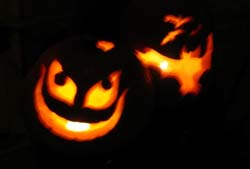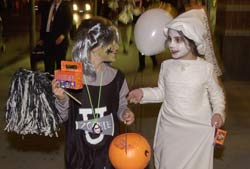Halloween Too Scary for Some Kids, Study Finds

It is the adults who should be afraid this Halloween. Not of ghouls and goblins, but of permanently scarring their children.
In a recent study of six- and seven-year-olds in the Philadelphia area, Penn State psychologist Cindy Dell Clark found that most parents underestimate just how terrifying the holiday can be for young kids.
Halloween has been scaring the heck out of kids of all ages for centuries.
Two thousand years ago, Celts living in what is now the United Kingdom celebrated their new year at the end of October. During these days of transition from the end of summer harvest to the beginning of winter, spirits were thought to roam among the living.
The modern customs of candy and costume are rooted in medieval England. To avoid being recognized by the visiting spirits, people would dress up in masks whenever they left home. Bowls of food were placed outside to keep the ghosts happy. The practices have morphed into Halloween as it is known today, with parents encouraging their own little ghosts and goblins to haunt the neighborhood.
There have been few studies to examine how the holiday affects children. Child psychologists generally caution parents that the fright of some aspects of Halloween can be too much for the very young, and advise adults to keep a close eye on children and remind them of what is real and what is not.
According to Clark, who interviewed parents and children after three Halloweens, younger children may be unwilling participants in the whole ritual.
Get the world’s most fascinating discoveries delivered straight to your inbox.
The key ingredient in the recipe of Halloween fright is, of course, death.
"Intriguingly, Halloween is a holiday when adults assist children in behaviors taboo and out of bounds," Clark writes in the anthropological journal Ethos. "It is striking that on Halloween, death-related themes are intended as entertainment for the very children whom adults routinely protect."
For most kids, at an age when they're often not included in family funerals or witness to grave illnesses, Oct. 31 is often their first introduction to the subjects.
Halloween also provides an opportunity for adults to confront usually uncomfortable topics like death, Clark told LiveScience. Kids as young as six and seven, however, don't differentiate between real death and the store-bought skeleton figures hanging in the trees and fake tombstones on the grass.
"Children see things on a real plane, as opposed to adults, who are trying to get around real themes like death by treating them as fun."
Conducting her study, Clark observed young children cowering from fear in front of the haunted displays and graveyard scenes common in so many American neighborhoods at Halloween.
Children interpret the frights of Halloween differently depending on their personal situations, such as the recent death of a relative or pet. An especially harrowing Halloween experience might have long-lasting effects. She recalled an interview with a grown woman who described trick-or-treating at age eight: A well-intentioned neighbor invited the girl inside, only to scare her and a friend with a real coffin displayed in the living room.
"She hasn't enjoyed Halloween since," Clark said.
- Candy Fears are Mere Halloween Phantoms
- The Truth Behind the Amityville Horror
- Posture Able to Communicate Fear
- Giving up the Ghosts
Halloween Safety
The Voice of Reason: There are only two confirmed deaths ever from Halloween candy. The scariest part is that the parents were to blame.
AP Photo
Dr. John Nagurney, a physician in emergency services at Massachusetts General Hospital and an instructor in medicine at Harvard Medical School, cautions:
"Every Halloween we see children brought to our emergency department with problems related to costumes, Nagurney says. "Masks that are ill-fitting interfere with vision, and outfits that are baggy or extend beyond ankles lead to trips and falls."
Also, if kids will be out after dark, put reflective tape on costumes and bags, and take a flashlight, Nagurney advises.
 Live Science Plus
Live Science Plus








